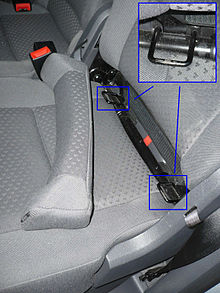Isofix

ISOFIX (known as LATCH [ "Lower Anchors and Tethers for CHildren" ] in the United States) is the ISO 13216 standard from the International Organisation for Standardisation, covering anchoring system for Group 1 child safety seats. It defines standard attachment points to be manufactured into cars, enabling compliant child safety seats to be quickly and safely secured. ISOFIX is an alternative to securing the seat with seat belts. Seats are secured with a single attachment at the top (top tether) and two attachments at the base of each side of the seat. The full set of anchor points for this system were required in new cars in the United States starting in September 2002.
In the UK and Europe the system is known as ISOFIX and covers both Group 0/0+ and Group 1 child safety seats. There are also various installation categories - "Universal", "Vehicle-specific" and "Semi-universal". The main difference being, "Universal" represents usage of a TopTether strap with the ISOFIX Anchorage, "Vehicle-specific" represents the usage of the ISOFIX Anchorage without the TopTetherin Specified vehicles only, while "Semi-Universal" represents usage of the ISOFIX Anchorage together with a "foot-prop".[1] [2]
For Group 2/3 seats there is a system called ISOFIT which anchors the seat to the vehicle so it cannot slide around when not in use. In the case of ISOFIT, the child is held into the seat using the vehicle's existing seat belt system, not the safety seat's straps.
External links
- Article and how-to video on LATCH and non-LATCH carseat installation
- ISOFix and passenger safety systems in road vehicles
- The AA: Child Safety
- Article on LATCH from KeepKidsHealthy.com
- Article on LATCH stating alternative names
- Auto 21 Study on booster seat usage in Canada
- clek - North American manufacturer of LATCH booster seats
